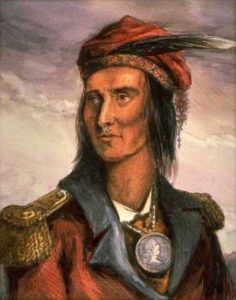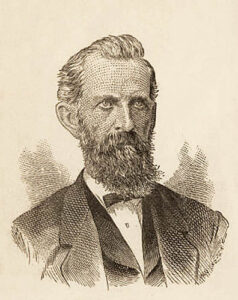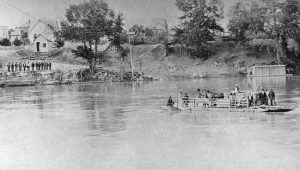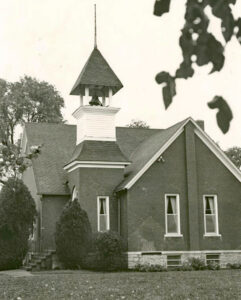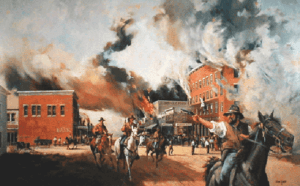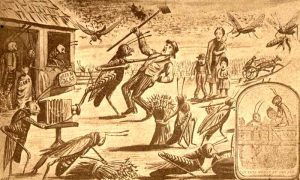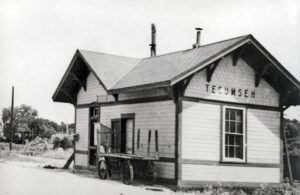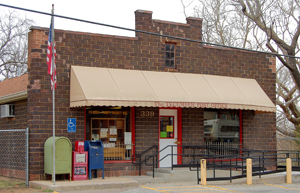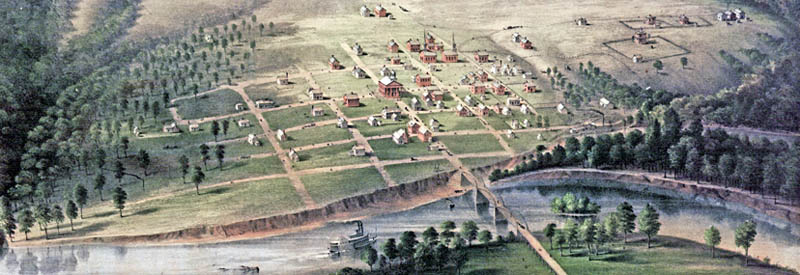
Tecumseh, Kansas Birdseye View, 1859
Tecumseh, Kansas, is a small unincorporated community along the Kansas River in east-central Shawnee County. As of the 2020 census, the population of the community and nearby areas was 696. The community was named for Shawnee Indian Chief Tecumseh.
Tecumseh got its start when Indian trader Thomas N. Stinson built a home on a 60-acre parcel in 1852. This was before Kansas Territory was opened to settlers, but he had married a Shawnee woman, and they received a direct land grant. His home was built near Shunganunga Creek; the land was broken and fenced by March 1853, and he moved his family to the farm.
Many Missourians and other Southerners settled in the area during the spring and summer of 1854. These settlers included J. K. Waysman, A. D. M. Hands, H. Walker, Albert Byler, Joshua Sartain, Nathaniel Hedrick, David Copeland, James Herron, Reuben Lowe, Reverend J. B. Stateler, John Horner, Francis Grassmuck, Judge Rush Elmore, Reverend H. J. Strickler, Charles Stevenson, and many others.
That year, Thomas Stinson and J. K. Waysman established a ferry to cross the Kansas River that was large enough for three wagons. Stinson’ house was located on an eminence overlooking Calhoun Bluffs north of the river. A good r ad was constructed for the ferry landing. The ferry was the principal crossing for the route from Leavenworth to the Sac and Fox and other Southern agencies.
In August 1854, the site for the city of Tecumseh was selected, and a 320-acre town site was surveyed. Of this, 240 acres were pre-empted for town purposes, and Thomas Stinson owned the balance. C. C. Spaulding made the survey on August 15, 1854. The proprietors of the townsite included Thomas Stinson, Judge Rush Elmore, and Albert Elmore of Alabama; Judge S. W. Johnson of Ohio; Governor Andrew Reeder of Pennsylvania; Samuel H. Woodson, Abram Comings, and Dr. James M. Hunter from Missouri; J. W. Whitfield of Tennessee; and Colonel A. J. Isacks.
By September 1, 1854, Thomas Stinson platted the townsite of Tecumseh. Pro-slavery partisans settled it in the turbulent days of Bleeding Kansas. It temporarily served as the pro-southern capital of the territory and prospered, even having a newspaper.
The first church service in Tecumseh was held in a tent on October 15, 1854, by Reverend Learner B. Stateler of the Methodist Episcopal South Church, which supported slavery. While preaching at the Methodist Episcopal South Church, Learner also preached as a missionary to the Native Americans in the area. That winter, a sawmill was established by Mr. Uptegraph and Morris, and William Vaughan and B. Sublette opened a store.
An Ohio native with connections to Kentucky, Thomas Stinson was a pro-slavery advocate. Maintaining these relationships during these turbulent years was not always safe or easy. Stinson’s friendship with the first territorial governor, Andrew Reeder, threatened to bring his family in harm’s way when the governor switched his allegiances from pro-slavery to antislavery. Reeder, irritated with Missourians’ illegal voting in Kansas, used his political and financial clout to promote a Free-State Kansas. In the spring of 1855, Reeder was threatened with death by a pro-slavery mob while visiting the Stinson home. Julia Stinson helped him escape.
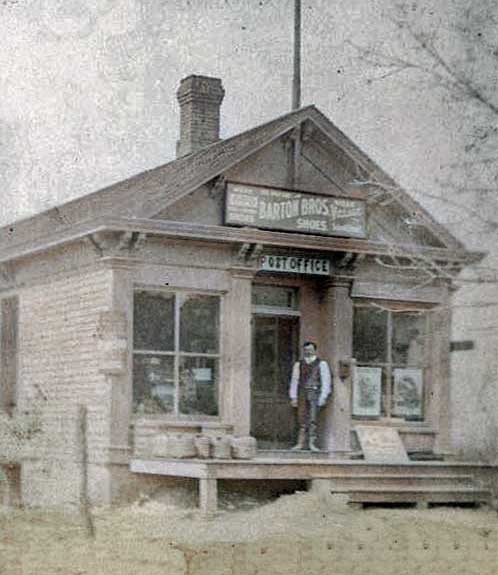
Tecumseh, Kansas Post office and general store, circa 1905. Touch of color by LOA.
A post office opened on March 3, 1855. Opened a part of a general store, the first postmaster was William A. Sublet.
A school was opened in the early spring of 1855 by William Ireland. Two mail routes were established about the same time, one from Tecumseh to the Sac and Fox agency, the other via the Pottawatomie Baptist Mission to Uniontown and Wabaunsee.
That year, Thomas Stinson was granted a 20-year charter to maintain his ferry with the law, providing that if the county tribunal failed to fix rates of ferriage, the rates prevailing the previous year should remain in force until changed by the county. At that time, James K. Waysman, who lived about two miles east of Tecumseh, rented the ferry from Stinson.
The following advertisement for this ferry appeared in Topeka newspapers.
“March 6, 1855
Tecumseh Ferry Kansas River. The nearest and best route from Fort Leavenworth to Council Grove. This ferry is now open and ready to cross teams, passengers, and freight at any hour. The ferry boat is large, entirely new, and built for this ferry.
The landings on both sides are excellent at all stages of water, and for swimming, cattle across is the best and safest place on the river. Emigrants and traders passing on the route between Fort Leavenworth and Council Grove will find this the shortest and easiest road, Tecumseh being on a direct airline from Fort Leavenworth to Council Grove. It is ni e miles from the ferry to the intersection of the Great Military Road on the north side of the river. Teams leave the Military Road at Rock Creek Crossing and thence across the old Parkville crossing of Muddy Creek. Distance from Rock Creek Crossing to Muddy Creek Crossing is 7 miles; thence to the ferry is 2 miles. Tecumseh is on the direct road from Westport to California. The total distance from Leavenworth to Tecumseh is 50 miles; thence to Council Grove, 65 miles; excellent grazing near each landing place free of expense.
T.N. Stinson, J.K. Waysman.”
In July 1855, the Bogus Legislature made Tecumseh the county seat of Shawnee County. A strong effort was also made to locate the Territorial capital at Tecumseh, but Lecompton proved a successful rival.
A description of the town, its condition, and its prospects appeared in an article published on August 4, 1855, in the Kansas Herald of Leavenworth. The writ r, after alluding to the completion of the stream sawmill and a large amount of lumber ready for use, further said:
“Three brickyards are now in operation, and large quantities of brick have been burned and are now ready for use. Dr. Hunt r is putting up a large brick store; W. A. M. Vaughan & Co. have several hands now engaged in collecting material for a large brick store, which they will commence in a week or two. The town company has contracted with Mr. Ayment to construct a brick hotel, seventy by forty feet, two stories high, and several other parties are making arrangements for building as soon as the weather moderates and workmen can be obtained. In addition to the stores of Vaughan & Co. and Ewing & Kavanagh, there are blacksmith and tailor shops and a very good log hotel, sixty by thirty feet, two stories high, and lean-to twenty by twenty feet. This hotel contains sixteen good-sized rooms, is just finished, and the furniture already put in.”
The Tecumseh Town Association was incorporated in August 1855 and, on September 17, entered into a contract with the County Commissioners for the erection of a two-story brick courthouse and jail.
The association donated the site for the building, and early in the spring of 1856, the work began. The brick and stone work was done by parties from Westport, Missouri, and the woodwork by Luther M. Carter. The courthouse was of brick, measuring 40 by 50 feet, two stories, with a portico supported by columns on the north. A broad corridor, with offices on either side, extended from north to south, the jail being in the southwest corner of the building. California-Oregon Trail Ferry across the Kansas River. The District and Probate Court was held in Tecumseh during the spring and fall of 1856, and the village became the “headquarters for the most distinguished pro-slavery legal talent in the district.” Also contributed to Tecumseh’s success were its many businesses, including a brickyard, two hotels, a grocery store, a shoe shop, a tailor shop, a blacksmith forge, a saloon, a sawmill, a sorghum mill, and a candy manufacturer.
That year, a bridge company was formed, which secured an exclusive charter for bridge building at Tecumseh and five miles west. The company contracted for an iron superstructure to be built at Cincinnati, the bridge to be 600 feet long, with two spans of 280 feet. The work of preparing abutments was commenced, but the enterprise ultimately failed.
Ferry charges over the Kansas River crossing at that time were: One wagon, two horses, $1; each additional span of horses or yoke of cattle, 25 cents; loose cattle or horses, per head, 10 cents; one horse and wagon, 75 cents; man and horse, 25 cents; foot passengers, 10 cents; sheep and hogs, 5 cents each.
In 1857, the Methodist Episcopal North, which was anti-slavery, bought a brick building where the church stands today. The North and South church stood adjacent to each other. Throughout the days of Bleeding Kansas and the Civil War, the pastors from both churches were taunted, threatened, and even had personal property destroyed by ruffians.
During 1857-1858, mills were built, stores well supplied with attractive merchandise opened on the streets facing the “Public Square”; the “Tecumseh Lyceum and Library” was chartered; three newspapers, the Southerner, the Settler, and the Note-Book, lived their ambitious but brief lives; pretty dwellings, with nicely cultivated gardens, were scattered along the principal streets. In 1858, Tecumseh’s prosperous days ended when Topeka became the new county seat due to a change in the majority of the legislature. From that time, the decay of Tecumseh was as rapid as had been its growth.
In 1858 and 1859, Achilles M. Jordan operated the Stinson Ferry.
In 1859, the public records were removed to Topeka. Businesses and manufacturers left, and free staters took control of the county. From then on, Tecumseh was a small farming community with a church, a doctor, and a general store that doubled as a post office.
In July 1862, Thomas Stinson signed as surety on a $500 bond with Remi H. Lecompte, who had secured a license for a ferry in that neighborhood. Lecompte’s ferry, in all probability, succeeded Stinson’s and operated from the same location.
After the Civil War, tensions between the two Methodist Church congregations ceased; the South church building became a school, and both congregations met in what used to be the “North Church.” By that time, the town continued to decline.
By the early 1880s, one historian stated of the town:
“Only enough remains to mark the ruin of the hopes of its founders. A single stone structure used for a store — the only one in the place — stands like a sleepy sentinel, facing the level, unfenced plat, grown rank with jimson weed and witch grass, once the “Court Square.” The streets are vacated, and the few remaining dilapidated houses stand, many of them untenanted and windowless, in undefined localities, having a melancholy air, as if deserted by their owners and too poor to escape. A post office, a country schoolhouse, and a plain brick church, Methodist, still linger on the site. Down what was the Main Street, going toward the river, the sides are lined with a shaggy, untrimmed hedge, beautiful in its rank foliage. At the foot was once its ferry landing and where the first bridge across the Kansas River gnawed away the bank. The trail passes over, but no passengers stop at the village of Tecumseh; no sound is heard save the hum of insects, the chirp of birds, and the long row of the straggling kine, grown fat upon the rank grass of the deserted streets.
In 1886, the brick courthouse was sold for $500 and removed, its brick and wood being utilized in building farmhouses.
To complement Tecumseh’s bad luck in the late 19th century, grasshopper plagues and smallpox epidemics ravaged the town, driving away more residents.
In 1910, Tecumseh was on the Atchison, Topeka & Santa Fe Railroad and had two stores, express and telegraph offices, and a money order post office with two rural routes. Its population was 35.
The Kansas Power & Light Company power plant was built in 1924 and 1925.
A high school building with three classrooms and a gymnasium was built in 1932, now serving as Tecumseh North Elementary.
As Topeka grew in the 1950s, Tecumseh again started to grow as a suburb of Topeka with numerous suburban housing subdivisions.
In 1958, DuPont Industries constructed the Futamura Cellophane Plant in Tecumseh along the Kansas River. This was due to the availability of water, electricity, and railroad tracks. The plant helped increase the Tecumseh area population from 3,000 to 5,000 people and added several hundred jobs. Between the cellophane and the power plant, Tecumseh became one of the wealthiest townships in Kansas. Today, i is the only remaining cellophane plant in the nation.
Tecumseh is located south of the Kansas River between Tecumseh Creek to the east and Stinson Creek to the west. Contained entirely within Tecumseh Township, it is about two miles east of the Topeka city limits. U.S. Route 40 passes the south side of Tecumseh. A Burlington Northern Santa Fe rail line between Lawrence and Topeka passes north of the town between it and the river.
©Kathy Alexander/Legends of Kansas, October 2023.
Also See:
Sources:
Blackmar, Frank. W.; Kans s: A Cyclopedia of State History, Volume I, Standard Publishing Company, Chicago, IL 1912.
Cutler, William G.; History of the State of Kansas; A. T. Andreas, Chicago, IL., 1883.
Tecumseh Walking Tour
Wikipedia

